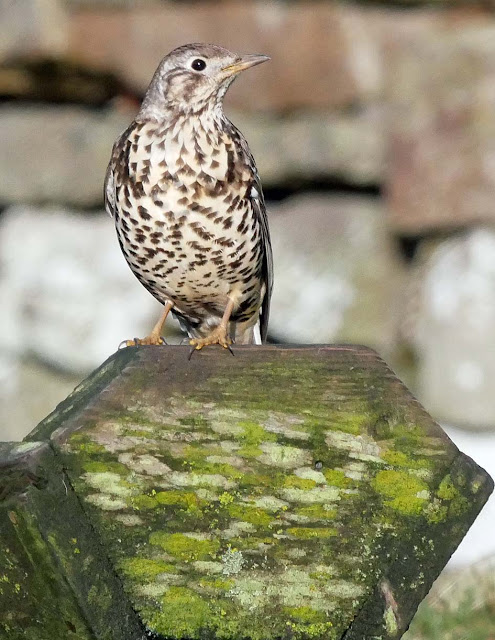Wednesday, January 31, 2024
Lacewing fly winter guest
Sunday, January 28, 2024
A waxwing at last!
It's thirteen years since we last saw a waxwing, when a whole flock turned up in our garden, feeding on crab apples. There have been numerous reports of these spectacular birds all over the north-east this winter, but it was only yesterday that we finally found one, feeding on hawthorn berries near Willington in the Wear valley. I didn't have a proper camera with me, so these pictures were taken with an iPhone 7 SE. Luckily, the bird was very obliging and let me get with a few feet before it flew higher into the tree.
Friday, January 19, 2024
Great-spotted woodpecker and Sitka spruce
Watched some interesting behaviour by a great spotted woodpecker recently. It arrived at a sallow carrying a Sitka spruce cone in its beak, then wedged it in a hole that it had already hacked with its beak, so it could use this as a vice to hold the cone while it pecked out the seeds. Sitka spruce is clearly a winter food source for this bird because there were scores of cones that it had discarded on the ground under its tree. The Sitka plantation nearby is carrying a very heavy cone crop this winter - enough seed to supply dozens of woodpeckers.
Saturday, January 13, 2024
Mistle thrush
Mistle thrushes tend to be wary birds, hard to approach closely. I photographed this one a couple of weeks ago at Stanhope in Weardale, managing to get within camera range because it was guarding a holly bush that was still loaded with berries. When they find a food source like this they'll defend it against all other thrushes and this one was reluctant to leave, even though it was clearly uncomfortable with my presence. I took a few pictures then left it to chase away a sneaky blackbird that had tried to plunder a few of the berries while the thrush's back was turned.
Monday, January 8, 2024
Nematodes: the most numerous animals on Earth
Nematodes, aka threadworms, aka roundworms are said to be the most numerous animals on Earth. Some are parasites but many are soil-dwellers living on decaying organic matter. A single hectare of heathy soil will be home to many billions of them. One study found an estimated 90 thousand in a single rotting apple, another found three million in a square metre of fertile ground.
Most are tiny: these, found in a pile of well-rotted leaves in deciduous woodland, were less than a centimetre long when full extended. They play a crucial role, along with soil fungi, in recycling nutrients from decaying plants.Because they are translucent, you can see the food particles that they've ingested passing along their gut during digestion - visible in these pictures as a series of dark particles along the length of the animal.
Friday, January 5, 2024
Winter fragrance
I planted a small cutting in our front garden many years ago for nostalgic reasons, because it grew on a roadside near my home in Sussex when I was a child. Its creeping underground rhizomes have spread relentlessly outwards, defying attempts to dig it out because it regenerates rapidly from small rhizome fragments left behind. Fortunately, it's confined by two walls and a concrete path, which limits its opportunities from further escape, but I can see why people warn against introducing it into cultivated soil.
It originates from the central Mediterranean region and North Africa and was introduced into gardens here in 1806, then first recorded in the wild in Middlesex in 1835. My favourite naturalised population is on the edge of the sea cliffs near Noses Point at Seaham on the Durham coast where, on a bright winter's day, it looks wonderful with the North Sea as a backdrop.









































